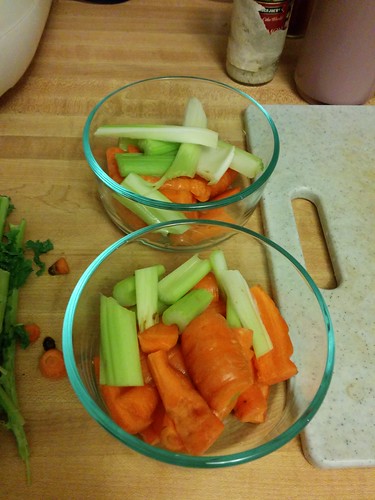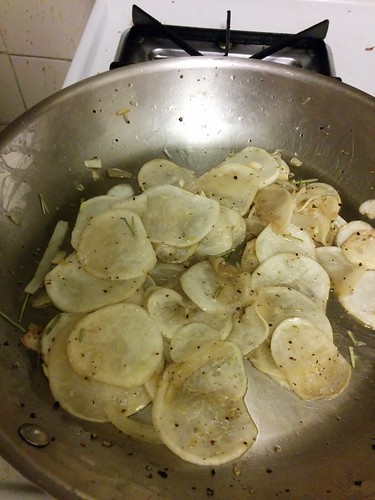Why we decided to compile our own family cookbook
Dec 7, 2014 · 5 minute read · CommentscookingvegetablescarrotscelerykalesalmonlemonrosemaryKretschmann Farm
Cooking has been a significant part of my life since 1999 when, shortly before reaching age 30, my bachelor self decided to completely change his unhealthy diet and lifestyle, and that meant finally getting down and dirty with seriously cooking for myself.
After getting married to Abby ten years later, cooking responsibilities have rotated between us based on the situation; there have been long stretches of time during which I did all the cooking every day, and there have been long periods during which she did all the cooking. Currently, we roughly split the cooking between us.
Why compile our own cookbook?
I’ve occasionally posted on this blog a recipe and/or photos of some food I’ve cooked, but for the most part, cooking is just a mundane everyday activity that I don’t keep track of, since the task of cooking is primarily utilitarian for us, not innovative or artistic. We simply need to eat every day, and prefer not to eat out often, for various reasons.
Recently I decided that we should start compiling our own family cookbook, noting details of what we prepare and how, in order to better replicate good results and improve on bad results, and make planning and impromptu cooking more efficient. Without our own cookbook, we have to rely on our faulty memories, and things sometimes don’t come out right (especially where the oven is concerned).
Below is an example of the kind of cooking we do. This is not a cooking blog, so I don’t expect to write much or often about our cooking, but I just felt like it tonight.
What I prepared tonight
Raw veggie sticks
We like to regularly cut up raw veggie sticks to eat as daytime snacks at work, or sometimes also as crunchy variety during regular meals as part of salads. I chopped up some carrots and celery for this purpose tonight. We often use other ingredients also, but tonight I just stuck to the basics. A list of some random options we’ve used (depending on season, availability in our Kretschmann Farm box subscription, and whim while out grocery shopping):
- carrots
- celery
- cucumbers
- peppers
- radishes
- parsnips
- beets
- turnips
The trick is simply to slice stuff lengthwise into reasonable widths, then chop them across to create reasonable lengths. No need to be exact. Also, we don’t bother to peel carrots.
Kale, boiled
We like kale. There are actually many different varieties with different colors and textures. Here’s some ordinary kale. I find it easiest to just boil it while preparing other foods. I test it periodically to make sure it is no longer tough to eat but still has some bite also and is not soggy. We boil the kale either in water or in our own homemade chicken broth that we make with the bones and other parts of whole chickens after eating the muscle meat.
Turnips, sauteed
OK, this is an example of something of an experiment that is going into the family cookbook.
We have cooked turnips in many ways (including, of course, as raw veggie sticks). Possibly the most common way we cook them is in the oven along with beets, potatoes, or the like, either as chunks or in “home fries” shapes. I’ve also prepared them as part of beef casserole dishes in the oven. Or as chicken stir fry with turnips. The possibilities are endless. You just have to be aware of how long they take to cook, and how thinly to slice for the purpose.
Tonight, I decided to slice the turnips very thin, for the purpose of creating a nice topping for the main dish.
- extra virgin olive oil
- turnips, sliced very thin
- some onion bits
- fresh rosemary
- salt and pepper
- garlic, generous amount
My habit these days when cooking in the skillet is to delay the introduction of the garlic, in order to give the result more kick.
Baked salmon
Finally, some fish (salmon). I have to confess that I’m not yet very happy about the results when I cook fish. Abby does a better job than me overall, so I usually let her cook fish. Still, both of us find it tricky to get fish just so: what’s the perfect balance between undercooked and overcooked?
I slightly overcooked the salmon tonight, for a couple of reasons: I forgot to get it out of the fridge earlier in the day to warm it up more before preparation, and I baked a bit too long as an attempt to make up for that.
Using the oven is always tricky for me. Higher temperature means cooking faster, but also means drying things out. For this dish, I decided on a temperature of 400 F for 30 minutes. Next time, if I have the salmon fully defrosted, I believe 20 should do the trick.
- extra virgin olive oil
- lemon slices
- salmon fillets, skin side down on top of the lemon slices
- salt and pepper
- fresh rosemary
- garlic, generous amount
- some onion bits
The result came out a bit dry, but other than that tasted great to me.
If you’re wondering “why rosemary in particular”, the answer is “our farm box from last week gave us a bunch and we need to use it”.
Conclusion
Cooking is a necessity but can be a pleasure or a frustration as well. There are times when I feel “lazy” and don’t want to cook and feel it’s a chore, but there are times when I feel slightly creative or experimental and want to make something I will find enjoyable to eat (and hopefully Abby will find enjoyable to eat also). Hopefully collecting our efforts into a cookbook will make it easier to whip up more variety when we are feeling “lazy” and don’t want to think too much.



